Finally reunited with Pittsburgh, Jaromir Jagr was Connor McDavid in the 1990s
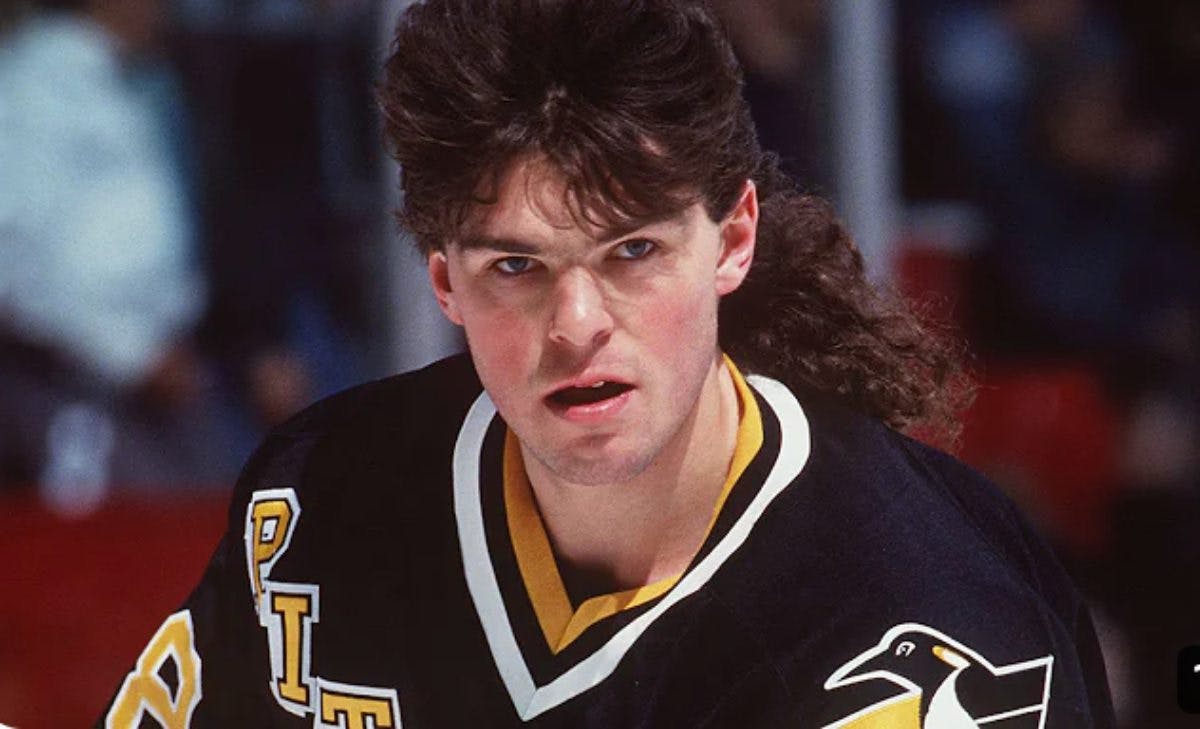
In his record 36 professional seasons, Jaromir Jagr has been many things. Junior hockey prodigy. The first Czechoslovakian allowed to attend the NHL Draft. Two-time Stanley Cup champion by age 20. Linemate, protégé, and rival to Mario Lemieux. Flashy, game-breaking superstar. Olympic gold medalist. Mercenary to the KHL. Treasured elder statesman. Player-owner into his 50s.
But Jagr was also his generation’s Connor McDavid. That’s not an exaggeration. And no statistical sleight of hand is necessary. With — or without — Lemieux around, Jagr was that consistently dominant.
This weekend, the prodigal son returns to Pittsburgh and the reunion will be spectacular. Many know Jagr only as a care-free, cult classic making headlines for longevity. But he was so much more. Today, we’re comparing Jagr to McDavid and ranking him among the NHL’s greatest forwards of all-time.
Jaromir vs. Connor
Watching Connor McDavid is a breathtaking experience. He’s a highly evolved cyclone of talent that even a casual fan can see is special. Physically, Jagr in his prime was much different. At 6-foot-3 and 230 pounds, Jagr was a German Shepherd to McDavid’s greyhound. With silky mitts on a power forward’s body, Jagr controlled the flow of the game using exceptional body positioning and vision.
Regardless of style, their respective results are eerily similar. How similar?
Here’s Jagr’s finest eight-year stretch (1993-2001) versus McDavid’s most recent eight seasons (2016-24). From left to right, the chart shows their best to “worst” 82-game point-scoring paces.
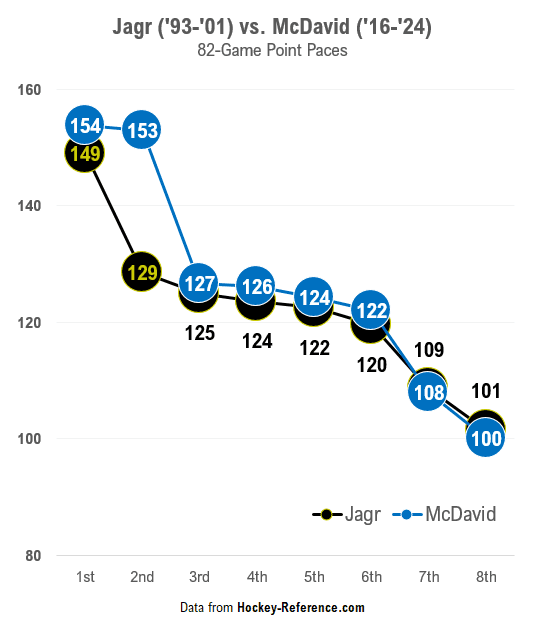
Incredibly, seven of the eight seasons are within a few points of one another over an 82-game schedule. Only their second-best seasons offer any edge, in this case to McDavid. But Connor had the benefit of scorching the makeshift Canadian Division in the abbreviated 2021 COVID year. Jagr, meanwhile, had to adapt to The Dead Puck Era as NHL offense vanished overnight in a puff of Zamboni smoke.
The inflection point is ideal for comparison as their game totals over the eight seasons are nearly identical right now. McDavid will likely net a sixth MVP finalist nod this year, and chasing down the scoring title isn’t out of the question, either. But in terms of overall body of work, there’s little separation between the pair.
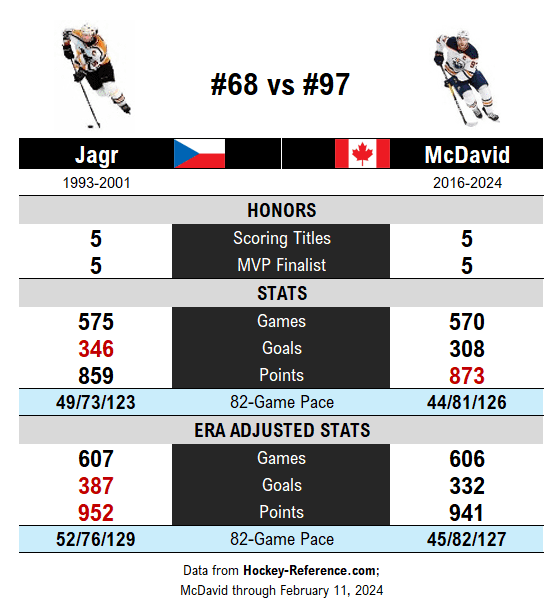
Or expressed differently…
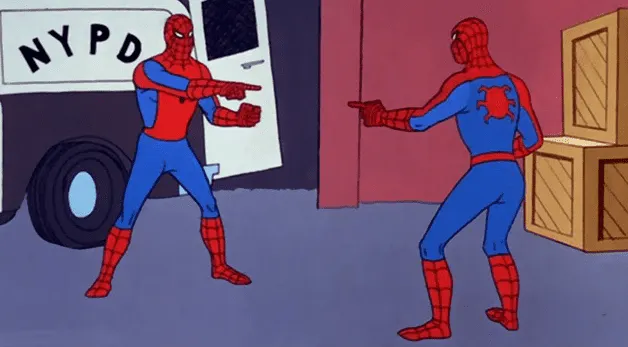
Yes, Jagr was McDavid good. Over eight seasons, Jagr was an equal point producer and a better goal scorer. After having the privilege to watch McDavid outclass the league for years, the statement feels absurd. The type that might get you kicked out of a group chat in Alberta. But the numbers don’t lie.
Now that we’ve got your attention, we’ll address the elephant in the room — Mario Lemieux. McDavid fans will surely point to Jagr riding shotgun with a player in the conversation for greatest ever. But over Jagr’s eight-year Penguin peak, Mario suited up for only 211 games — roughly one-third of the schedule.
In the seasons with Mario, Jagr was a 124-point player. Without Mario? 120. Negligible, really.
In fact, Jagr won four of his five scoring titles when Lemieux was fully retired. In the comparison above, McDavid’s eight seasons have often been stapled to a fully healthy Draisaitl, an all-world player also at the peak of his powers. As singular a talent as Lemieux was, playing eight years with Leon surely trumps fragments of four with Mario.
Why is Jagr so underappreciated?
It begs the question how Jagr was never celebrated the same way McDavid is today. Five scoring titles in seven years… in an era where offense was shrinking by the season. What are we missing?
Jagr — outspoken, confident, playful and flamboyant — rocked the NHL’s old-school culture. Big hair. Big post-goal salutes. Big personality. Jagr was the type of player fans dream of today. But not back then. Europeans weren’t well received when the league’s floodgates opened in the early 1990s.
The fall of The Iron Curtain and the influx of exceptional talent to North America should have been a welcome sight. Much like today, hockey is usually a decade late and a million dollars short on embracing change. Questioning the toughness of Europeans was common. As was intentionally mispronouncing their names. Labeling Euros as “enigmatic” or bad for team dynamics dismissed their impact. Mocking visors, long grandfathered into the NHL, was another tool of ignorance. Falsely suggesting Europeans faded in big moments completed a full line on the Don Cherry bingo card. Jagr entered an NHL littered with xenophobia.
Richard, Beliveau, Orr, Lafleur, Gretzky, Lemieux, Lindros. That was how it was supposed to be.
Jagr disrupted hockey’s order. He didn’t care, either. Outside of Pittsburgh, his renaissance as a legend emerged later in life. Nearly two decades later. Only in his 40s did his relentless desire, fun-loving persona, and quirky training methods shine light on the passion and ability overlooked in his prime.
Jagr’s Place in History
Jagr is second all-time in points (1,921), fourth in goals (766) and only Gretzky, Lemieux, and Gordie Howe have more scoring titles. Jagr played in a low-scoring era and spent three seasons in the KHL. If not for those seasons away — plus three separate NHL lockouts — the all-time goals record was very much in play.
Perhaps the greatest mark of his brilliance? As an 18-year-old, ‘Jags’ scored 27 goals. A quarter century later, at age 43, he scored 27 goals. That’s 27 goals when he was five years younger than Cole Caufield is today. And 27 goals when he was five years older than Alex Ovechkin is today. Inconceivable, really.
And in between? He was Connor McDavid’s equal in his 20s.
Where does that place Jagr among the greatest ever?
- In 2021, The Hockey News named its Top 75 Players of All-Time. Jagr was 21st, or 11th among forwards. Like most subjective player rankings, that list leans nostalgic.
- In 2023, The Athletic ranked Jagr the fifth-best player — and #4 forward — since the 1967 expansion. That’s more like it.
- By PPS score, my comprehensive Hockey Hall of Fame worthiness metric, he ranks fourth among all forwards. Ahead of Howe and Ovechkin. While PPS does not attempt to measure off-ice impact, it’s revealing because it limits objectivity. For context, it took Sidney Crosby until last season to edge past Jagr in PPS.
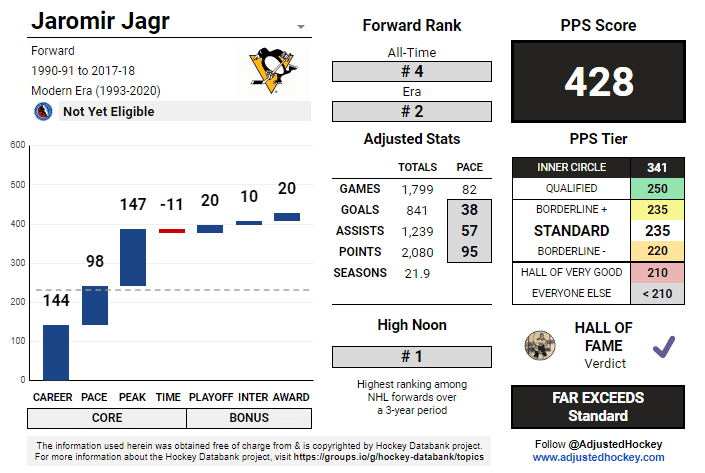
It will be at least three years until Jagr is Hall of Fame eligible in 2027 — that’s if he finally retires this year. Jonathan Toews, 16 years Jagr’s junior, will be elected before him. Jagr had won two Cups before Toews entered kindergarten. That’s how long Jagr has been playing professionally.
On Sunday, his familiar #68 takes permanent residency in the PPG Paints Arena rafters, rightfully beside his childhood idol and collaborator Lemieux. But amongst the energy, jokes, and tears in the building, take the time to remember one of the greatest players in NHL history.
While he didn’t receive the appropriate praise at the time, Jaromir Jagr was the Connor McDavid of his generation. And that’s how he should be remembered.
Follow @AdjustedHockey on X; Data from Hockey-Reference.com
_____

Discover Betano.ca – a premium Sports Betting and Online Casino experience. Offering numerous unique and dynamic betting options along with diverse digital and live casino games, Betano is where The Game Starts Now. 19+. Please play responsibly.
Recently by Paul Pidutti
More from Paul Pidutti
- Father Time 2025: Are McDavid, Binnington and others on the decline?
- Surprise: great players rarely make great NHL coaches
- Overtime, loser points unleashing chaos in NHL’s Season of Parity
- Projecting the 2026 Hall of Fame Class: Bergeron, Price and endless possibilities
- Hall of Fame tiers: Which NHL stars are destined for immortality?